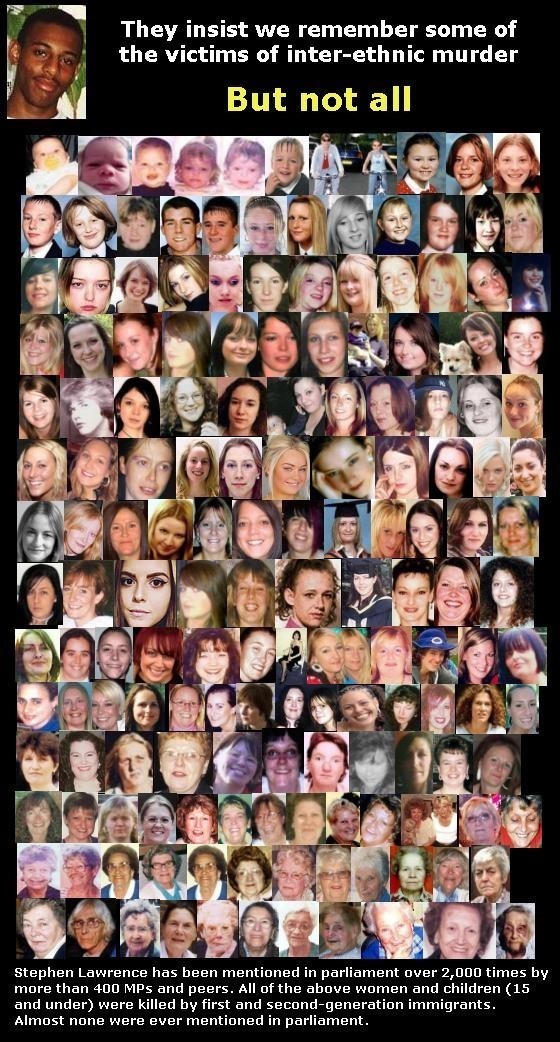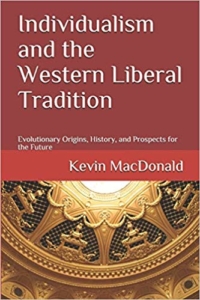The Psychology of Moral Communities, Part 1 of 5
Editor’s note: I am moving (gruesome, as always) and will likely be away from my computer for a few days, so I thought I would post Chapter 8 of my 2019 book Individualism and the Western Liberal Tradition: Evolutionary Origins, History, and Prospects for the Future, in five parts. This is the longest chapter in a long book and is basic to the entire project.
Human rationality consists largely of separating intellectual argument from personality attributions about moral character. Our difficulty in making this separation suggests that political, religious, and pseudo-scientific ideologies have been part of moralistic self-display for a very long time.
Geoffrey Miller, The Mating Mind[1]
This book has emphasized that the liberal strain of Western culture stems ultimately from European individualism which in turn can be found at the very origins of the European peoples. As noted in several places, a fundamental aspect of individualism is that group cohesion is based not on kinship but on reputation—most importantly in recent centuries, a moral reputation as capable, honest, trustworthy and fair. Reputation as a military leader was central to Indo-European warrior societies where leaders’ reputations were critical to being able to recruit followers (Chapter 2). And the northern hunter-gatherer groups discussed in Chapter 3 developed egalitarian, exogamous customs and a high level of social complexity in which interaction with non-relatives and strangers was the norm; again, reputation was critical to remaining in the group.
The reputation-based moral communities of the West thus have deep historical roots both in Indo-European culture and in hunter-gatherer culture. In Chapter 5 I noted that Christian Europe had become a moral community based on Christian religious beliefs rather than ethnic or national identity. Moreover, the abbots and prelates of the medieval Church, the Puritan and Quaker religious leaders of the seventeenth and eighteenth centuries, and the liberal intellectuals of the nineteenth centuries discussed in later chapters carried on the primeval tendency to create moral communities as a source of identity. Finally, as discussed below and in Chapter 9, such moral communities have come to define the contemporary culture of the West.
These moral communities are indigenous products of the culture of the West—products of Western culture in the same way that kinship-based clans, cousin marriage, sequestering women, and the harems of elite males are products of the people of the Middle East.
My view is that the moral communities observed at the origins of Western history and surfacing recurrently in later centuries tapped into a pre-existing tendency among individualists to create such communities as a force for cohesion that does not rely on kinship relations. Particularly important since the seventeenth century have been the egalitarian moral communities based on a hunter-gatherer ethic whose evolutionary origins are discussed in Chapter 3. Beginning after World War II and accelerating greatly in the 1960s and thereafter, these moral communities have been defined by the intellectual left which is bent on dispossessing European-derived peoples from territories they have dominated for hundreds, or in the case of Europe, many thousands of years.
Moral communities are pervasive throughout the institutional structures of the West; however, because of their widespread influence, moral communities are particularly noteworthy in the media and the academic world. For example, whereas mainstream social science had been relatively free of morally based ingroup-outgroup thinking prior to World War II, such thinking has had dramatic effects on the social sciences and humanities in later decades, to the point that academic departments and scholarly associations in these areas can be accurately characterized as “tribal moral communities” in the sense of Jonathan Haidt.[2] This is most obviously the case in areas such as social psychology, sociology, and ethnic and gender studies.
The result has been that academic research communities and the media rigorously police research and commentary that conflict with racial egalitarianism or promote the interests of European-derived peoples, and these attitudes have been internalized by a great many White people. Researchers such as Arthur Jensen, Richard Lynn, J. Philippe Rushton, and Ralph Scott who attempt to publish findings on race differences or on public policies related to race find themselves socially ostracized, and they quickly learn that there are steep barriers to publication in mainstream academic journals and no mainstream grant support for their research.
For example, when scholarly articles contravening the sacred values of the tribe are submitted to academic journals, reviewers and editors suddenly become extremely “rigorous”— demanding more experimental controls and other changes in methodology. Such “scientific skepticism” regarding research that one dislikes for deeper reasons was a major theme of The Culture of Critique in discussions of the work of Franz Boas, Richard C. Lewontin, Stephen Jay Gould, and the Frankfurt School, to name a few.[3]
One result of this academic reign of terror has been that conservatives often self-select to go into other areas that are not so compromised, such as the hard sciences or computing; there is also active discrimination against conservative job candidates and Ph.D. applicants.[4] The system is therefore self-replicating.
Social Identity Processes as an Adaptation for Moral Communities
In previous work I have argued for an evolved basis for social identity processes.[5] People are prone to creating positively valued ingroups in which the outgroup is negatively valued—a human universal. The negatively evaluated outgroup need not be defined by kinship—cultural categories, such as “likes modern art” vs. “hates modern art” or if groups have different-colored uniforms (as at sporting events) are able to produce positive attitudes towards ingroup members and negative attitudes toward outgroup members. Because social identity processes are not necessarily defined by kinship, Western peoples are particularly prone to these processes.
William Graham Sumner was a Darwinian anthropologist whose work was mentioned in Chapter 6 as typical of the intellectual elite of the late nineteenth–early twentieth century that fed into the movement for ethnic defense leading to the 1924 immigration restriction law. He expressed the essentials of social identity processes as they play out in tribal societies as follows:
Loyalty to the group, sacrifice for it, hatred and contempt for outsiders, brotherhood within, warlikeness without—all grow together, common products of the same situation. It is sanctified by connection with religion. Men of an others-group are outsiders with whose ancestors the ancestors of the we-group waged war. … Each group nourishes its own pride and vanity, boasts itself superior, exalts its own divinities, and looks with contempt on outsiders. Each group thinks its own folkways the only right ones, and if it observes that other groups have other folkways, these excite its scorn.[6]
The only difference from contemporary research into social identity is that the references to ancestors of the ingroup and the outgroup need not apply. Sumner’s quote would thus not apply to the West where the important historical groups discussed here are not based on ancestry but on being a member of a moral community.
Social identity research conducted in Western societies shows that ancestry of ingroup and outgroup is not important for people having positive attitudes about their ingroup and negative attitudes about outgroups.[7] Within the group there are higher levels of cohesiveness, positive emotional regard, and camaraderie, while relationships outside the group can be hostile and distrustful. The tendency for humans to place themselves in social categories often has powerful emotional consequences, including guilt from violating group norms, empathy for ingroup members, hatred and discrimination against the outgroup, and increased self-esteem because ingroup members see themselves as a member of a superior group. For moral communities, this implies that ingroup members see themselves as morally superior and as acting from ethically pure motives while seeing outgroup members as evil, morally depraved, lacking all human decency, etc.
Attesting to the lack of importance of kinship for creating group conflict, ingroup favoritism and discrimination against outgroups occur even in so-called “minimal group experiments”—i.e., experiments where groups are constructed using random labels for ingroup and outgroup. Ingroup favoritism and discrimination against outgroups thus occur even if there are no conflicts of interest between the groups or indeed any social interaction at all. Even when the experimental subjects are aware that the groups are composed randomly, subjects attempt to maximize the difference between the ingroup and the outgroup, and they do this even when such a strategy means they would not maximize their own group’s rewards. The important goal seems to be to outcompete the other group. These studies attest to the power of “groupness” in the human mind—the tendency for even the most randomly constructed groups to elicit discrimination against outgroups.
My literature review concluded that social identity processes are a psychological adaptation (i.e., they are an evolved result of natural selection) designed for between-group competition.[8] For example, social identity processes have been found in a very wide range of societies, whether or not these societies are based on extended kinship. And they can be found very early in life—even before there is any specific knowledge about the outgroup. Moreover, cognitive processing of ingroups and outgroups is automatic—not the result of conscious reflection, but more like an innate psychological reflex akin to blinking in response to a sudden burst of intense light.
Another indication of the evolutionary origin of social identity processes is that these tendencies toward positive evaluation of the ingroup and devaluation of the outgroup are exacerbated by real conflicts of interest between groups.[9] In other words, even though relatively mild versions of these phenomena occur in minimal groups, they are much stronger where there are real conflicts of interests. This is important because psychological adaptations typically show graded responses to environmental context. For example, most people tend to have natural, reflexive fears of things that were dangerous over evolutionary time—things such as snakes, spiders, and heights—whereas this does not tend to occur with lethal modern inventions like guns or nuclear radiation. However, reflexive fear is likely to be less extreme if the feared object is caged in a zoo or if one is a safe distance from the threat. Responses are thus graded according to the intensity of the provoking event.
Recall in Chapter 6 that millenarian attitudes, while very characteristic of American politics, tend to go into dormancy, only to be resurrected in times of presumed peril or crisis—“the expansionist period, the Civil War, the First World War.”[10]
Like a recessive gene, in the right situation [messianic moral crusading based on constructing a morally defined ingroup] could become dominant. In the years preceding American entry into each of the great wars, there was first a period of passionate non-involvement. This reaction no doubt was perfectly natural, but there was a special moral tone to the expressions of political leaders; the wars, it seemed, were destined to catch the righteous nation in the old web. Eventually, however, the trumpets of Zion began to be heard, and a millennialist kind of enthusiasm was generated. The great wars of our history have all to a considerable extent been regarded as Armageddon—which surely was near. After the war had been won, and evil conquered, a permanent era of peace and prosperity would begin.[11]
In contemporary times, one thinks of the wars in Iraq and Libya, advertised in part as moral crusades to remove evil dictators, Saddam Hussein and Muammar Gaddafi respectively, and to install a democratic regime that would ensure a bright future for these countries. (In both cases, the wars have not quelled previously existing ethnic and religious conflict.) In the quote from Tuveson, notice that the political rhetoric of both the isolationist period prior to the war and the war itself is couched in moral terms and relies on creating morally defined ingroups and outgroups, as in the period prior to World War II when isolationists dominated public discussion (but not Roosevelt Administration policy) prior to Pearl Harbor.
Moreover, our contemporary political rhetoric is saturated with attributions of moral superiority, and increasingly we are seeing this rhetoric being linked to physical harassment and even violence. Because the left has attained the moral high ground in the media and in education (from elementary school through university), moral communities of the left are particularly powerful. It is not at all uncommon to see attributions of moral depravity hurled at conservatives and particularly at members of the racialist right.
Despite the current regime of relatively low-level harassment and violence, if history is any guide, we are still mainly in the phase of non-violent conflict. Condemnations of harassment and physical violence are still common among establishment figures of both left and right. However, this phase will likely be followed by assertions that any and all means may be undertaken to destroy the morally depraved enemy, including violence, with the stated goal of establishing a permanent reign of peace, love, and ethnic harmony. Indeed, there have already been numerous instances of violence by self-styled antifa groups.[12] This utopian future will be advertised in defiance of everything we know about human nature and the costs of multiculturalism, particularly the effects of multiculturalism on increasing between-group conflict.[13]
The Role of Empathy in Moral Communities: Altruism—and Pathological Altruism
In a later section of this chapter on race differences in personality, I describe the personality system of Love/Nurturance and note that it is stronger in European culture than other human cultures (see also Chapter 3). Briefly, Love/Nurturance is an evolved system linked to specific brain regions coding for positive feelings in response to being loved and nurturing others; empathy—which results in personal distress at seeing the suffering of others, especially loved ones—is a central emotion of the Love/Nurturance system. The extreme ends of individual differences in the Love/Nurturance system are linked to sociopathy at the low end (callous unconcern regarding the feelings of others, lack of remorse or guilt, cruelty) to dependency disorder (overly prone to needing social approval and love) and pathological altruism (overly prone to guilt and empathy to the point of self-sacrificing, self-harming behavior) at the high end.[14] Because of its role in cementing family relationships and nurturing children, women are higher on the Love/Nurturance system and thus more prone to empathy than men.
Whereas sociopaths are unconcerned with receiving affection or being liked by others, people who are at least moderately high on the Love/Nurturance system value being liked by others. This tendency to want to be liked can interfere with rational judgments. The default mode of human reasoning is socially embedded in social interactions,[15] and social predilections, such as wanting to be liked, may prevent rational assessments of costs and benefits of actions. Thus people may make rational judgments based on data or past experience that enabling more refugees to come into their city will lessen social homogeneity as well as strain social services and the school system. But they may still publicly approve a refugee program because they would be more likely to get social approval from friends and neighbors in their face-to-face world. Indeed, they may go out of their way to advertise their attitude—what is now termed “virtue signaling.”
For individualists (i.e., people who are less prone to negative attitudes toward outgroups and strangers), being on the high end of empathy can easily lead to a pathological form of altruism where high costs can be incurred with no corresponding benefit. Pathological altruism is generally defined as focusing on others’ needs to the detriment of one’s own needs.[16] Such altruism, motivated by what one might label “hyper-empathy,” is more common among females—which fits with females generally being higher on the Love/Nurturance system.[17] It can lead to pathological consequences for both the altruist and the intended beneficiary, as in the phenomenon of co-dependence where one person’s altruism facilitates maladaptive behaviors in another person, such as drug addiction by being overly solicitous and tolerant of another’s self-destructive behavior.
Normal levels of wanting to be liked as well as pathological altruism often involve a sense of self-righteousness, which can be translated as a sense of moral superiority that advertises one’s good reputation within a community defined, as prototypical European groups are, not by kinship but by conforming or exceeding the moral standards of the community. As noted above, such expressions of moralistic self-righteousness have a long history in Western societies and are very salient in contemporary political rhetoric.
It’s interesting that moral outrage, especially by males, acts as a cue to mate value in monogamous marriage that is a fundamental marker of Western social structure.[18] Since women want mates who fit into their moral community, men who signal moral outrage compatible with the values of that community are seen as good marriage prospects.
An example of how self-righteous virtue signaling works at the highest levels of government can be seen in the comments of David Goodhart, a liberal journalist on migration:
There has been a huge gap between our ruling elite’s views and those of ordinary people on the street. This was brought home to me when dining at an Oxford college and the eminent person next to me, a very senior civil servant, said: ‘When I was at the Treasury, I argued for the most open door possible to immigration [because] I saw it as my job to maximise global welfare, not national welfare.’ I was even more surprised when the notion was endorsed by another guest, one of the most powerful television executives in the country. He, too, felt global welfare was paramount and that he had a greater obligation to someone in Burundi than to someone in Birmingham. … [The political class] failed to control the inflow … in the interests of existing citizens.[19]
An evolutionist can only marvel at the completely unhinged—pathological—altruism on display here, given that the people making these policies are presumably native White British themselves.
As noted in Chapter 7, this overweening concern with people of different races living in far off lands at the expense of one’s own people was characteristic of many nineteenth-century English intellectuals, particularly those associated with Exeter Hall, who exhibited what Charles Dickens described as “platform sympathy for the Black and … platform indifference to our own countrymen.”[20] In his novel Bleak House, serialized in 1852–53, Dickens portrayed such sentiments in the character of Mrs. Jellyby, whose “handsome eyes had a curious habit of seeming to look a long way off. As if … they could see nothing nearer than Africa.”[21] Mrs. Jellyby neglected those around her, including her daughter, her thoughts directed instead towards the fictitious African possession of Borrioboola-Gha and her idealistic plans for its development.
It is well-known that massive non-White immigration has had negative effects most of all on the traditional, White working class of Western societies, while wealthier Whites can escape the problems brought about by immigration by moving to other neighborhoods—the phenomenon of White flight. They also tend to have jobs, such as in journalism, that have not been impacted by immigration, although visas for workers in technical areas are increasingly common. However, contemporary liberal-minded elites throughout the West are indifferent or even dismissive of the negative effects of immigration on the White working class in terms of lowered wages,[22] lessened community cohesion and involvement,[23] and deteriorating public schools. As noted, in Mrs. Jellyby’s case, this included neglecting her own children—also characteristic of contemporary liberals who typically fail to think seriously about the effects of mass non-White migration on the long-term prospects of their own children as a minority in a majority non-White society.
Such expressions of high-mindedness are attempts to fit into a moral community as defined by the media and accepted by their peers. Because the left dominates the moral high ground, expressing empathy for the native Whites, especially the White working class, makes anyone with such ideas into a moral pariah, as would advocating for their interests, with likely negative effects on career prospects. Indeed, expressions of White identity and especially having a sense of White interests have been condemned by establishment media and academic figures as illustrating the lowest form of moral depravity.
Of course, the motives involved in such cases may involve more than empathy for suffering others. While these elite Whites may feel genuine empathy for suffering others in foreign lands to the point of wanting to inundate the West with them, they are also in effect buttressing their status in the morally defined ingroup. They may even be attempting to be “more moral than thou”—competitive virtue signaling—by out-empathizing others in the group. And whether consciously or unconsciously, they may be aware of severe costs if they fail to conform to the norms of their moral community—as well as the benefits of conforming.
As expected given the above-noted sex differences in empathy, women are more prone to pathological altruism than men—the prototype being the long-suffering wife who continues to nurture an abusive, alcoholic husband. Pathologically altruistic people respond very strongly to images of suffering refugees, immigrants, and other non-Whites. And as noted regarding empathy, there are specific brain regions that are activated when a subject feels sympathy for others. Indeed, Williams Syndrome, a genetic disorder, is characterized by being overly trusting and sympathetic.
The conviction of self-righteousness characteristic of pathologically altruistic people need not be rational:
What feels like a conscious life-affirming moral choice—my life will have meaning if I help others—will be greatly influenced by the strength of an unconscious and involuntary mental sensation that tells me that this decision is “correct.” It will be this same feeling that will tell you the “rightness” of giving food to starving children in Somalia, doing every medical test imaginable on a clearly terminal patient … . It helps to see this feeling of knowing as analogous to other bodily sensations over which we have no direct control.[24]
In other words, the sensations of rightness and nobility act as psychological reflexes, and they are so pleasurable that people are inclined to seek them in their own right and without regard to facts or the long-run consequences to themselves.
Talk to an insistent know-it-all who refuses to consider contrary opinions and you get a palpable sense of how the feeling of knowing can create a mental state akin to addiction. … Imagine the profound effect of feeling certain that you have ultimate answers. … Relinquishing such strongly felt personal beliefs would require undoing or lessening major connections with the overwhelmingly seductive pleasure-reward circuitry. Think of such a shift of opinion as producing the same type of physiological changes as withdrawing from drugs, alcohol, or cigarettes.[25]
Feelings of moral righteousness may thus be pleasurable and lead to addiction. “Sanctimony, or a sense of righteous outrage, can feel so intense and delicious that many people actively seek to return to it, again and again.”[26]
The pleasure of knowing, with subjective certainty, that you are right and your opponents are deeply, despicably wrong. Or, that your method of helping others is so purely motivated and correct that all criticism can be dismissed with a shrug, along with any contradicting evidence.[27]
This type of sanctimoniousness is, of course, particularly common among the people labeled “Social Justice Warriors.” These are the people screaming “racist,” “misogynist,” “white supremacist,” etc. at any seeming violation of the norms of the moral communities of the left. And, because of the cultural hegemony of the left, such people can often be seen on social media (and in op-eds in the mainstream media) expressing their moral righteousness—a moral righteousness that fits with or extends the boundaries of the cultural left.
Another aspect of this is competitive altruism or competitive virtue signaling. Given that expressions of moral righteousness are typically communicated in a social setting and are aimed at solidifying or enhancing one’s reputation within a group, there may be competition for ever more extreme expressions of self-righteousness—even among people who are not biologically inclined to be high on the Love/Nurturance system. Extreme expressions of moral righteousness are not only addicting, they may also raise one’s status in a social group, just as it’s common for religious people to express “holier than thou” sentiments. Strongly religious people compete to be most virtuous in their local church. On the left, we see vegan fanatics shunning vegans who even talk to people who eat meat or eat in restaurants where meat is served—even family members. I imagine there is a dynamic within antifa groups—the shock troops of the establishment’s views on race and migration—where people who do not condone violence or are unwilling to crack heads themselves are ostracized or at least have much less status.
The result is a “feed forward” process in which the poles of political discourse move ever farther apart. For example, well-publicized attacks on Confederate statues have quickly morphed into attacks on Thomas Jefferson, George Washington, and Christopher Columbus. Sympathy among liberals for granting amnesty to illegal immigrants has morphed into calls by prominent Democrats to abolish the Immigration and Customs Enforcement Agency (ICE), make border crossing legal, and give them health care, driver’s licenses, voting rights, and ultimately citizenship. Inviting anyone remotely associated with conservative ideas—much less the racialist Right—to give a talk at a college campus has morphed from a tolerated rarity to a context for angry protests, rioting, injuries to conservatives, and damage to property.
Indeed, I suggest that this competitive virtue signaling is a major cause of the increasing polarization that we see in the United States and throughout the West in the age of social media. A Pew Research Center survey on changes in U.S. political culture from 1994–2017 found that the increasing divide between Republicans and Democrats, especially on immigration and race, was much more due to the median views of Democrats shifting left.[28]
Nevertheless, a theoretically similar phenomenon exists on the right as, for example, when individuals condemn others for being insufficiently militant or ideologically pure. However, because the left dominates the cultural landscape, such competitive virtue signaling has had most of its effects on the left. Such competitive virtue signaling from both the left and the right is highly characteristic of the social dynamics of social media sites and journalism.
People on the right face the danger of “doxxing,” having their identity and personal information made public. Hosts of shows in the mainstream media may have to cope with losing sponsors and hence their livelihood; e.g., as of March, 2019, Fox News host Tucker Carlson had lost around 30 sponsors, mainly because of his comments on immigration.[29] Or people may fear losing their job as a result of a phone call to their place of employment by a self-described “civil rights” organization such as the Southern Poverty Law Center or the Anti-Defamation League. This may well be why it is the left that has become more extreme in recent decades, whereas far too many on the right attempt to mollify their leftist critics by knuckling under to their moral righteousness.
The cultural domination of the left has meant that certain views are off-limits for all but the most daring. Thus, media sites like Breitbart and The Daily Caller, while definitely to the right of the mainstream media, avoid explicit advocacy of White identity and interests. Such constraints are much less apparent on the left, with the result that the left continues to get more and more extreme in their views. As I write, views on immigration noted above and on abortion (making abortion legal up until or even shortly after birth) that used to be virtually non-existent among Democrats are increasingly being espoused by mainstream Democrat politicians and pundits.
A critical consequence of this is racial polarization. White Americans have been shifting toward the Republican Party—the last Democrat president to get a majority of White votes was Lyndon Johnson in 1964. In general, this is an expression of implicit Whiteness (discussed below), as non-White groups coalesce in the Democratic Party. The point here is that such trends are likely to increase and polarization become more severe.
[1] Geoffrey Miller, The Mating Mind: How Sexual Choice Shaped the Evolution of Huan Nature (New York: Anchor Books, reprint, 2001), 332.
[2] Jonathan Haidt, “Post-partisan Social Psychology.” Presentation at the meetings of the Society for Personality and Social Psychology, San Antonio, TX, January 27, 2011.
http://people.stern.nyu.edu/jhaidt/postpartisan.html
[3] Kevin MacDonald, The Culture of Critique: An Evolutionary Analysis of Jewish Involvement in Twentieth-Century Intellectual and Political Movements (Westport, CT: Praeger, 1998; 2nd edition: Bloomington, IN: AuthorHouse, 2002), especially Chs. 2 and 6.
[4] Kevin MacDonald, “Why are Professors Liberals?,” The Occidental Quarterly 10, no. 2 (Summer, 2010): 57–79.
http://www.kevinmacdonald.net/Professors.pdf
[5] Kevin MacDonald, “An Integrative Evolutionary Perspective on Ethnicity,” Politics and the Life Sciences 20 (2001): 67–79; see also Ch. 1 of Separation and Its Discontents: Toward an Evolutionary Theory of Anti-Semitism (Westport, CT: Praeger; 2nd edition: Bloomington, IN: AuthorHouse, 2002).
[6] William Graham Sumner, Folkways (New York: Ginn, 1906), 13.
[7] Kevin MacDonald, “An Integrative Evolutionary Perspective on Ethnicity.”
[8] Ibid.
[9] Miles Hewstone, Mark Rubin, and Hazel Willis, “Intergroup Bias.” Annual Review of Psychology 53 (2002): 575–604; Michael A. Hogg and Dominic Abrams, Social Identifications (New York: Routledge, 1987);
[10] Ernest Lee Tuveson, Redeemer Nation: The Idea of America’s Millennial Role (Chicago, University of Chicago Press, 1968), 199.
[11] Ibid., 214.
[12] Natalie Richardson, “Two More Oregon Men Left Bloody after Violent Antifa Attack at Portland Protest,” Washington Times (July 1, 2019).
https://www.washingtontimes.com/news/2019/jul/1/two-more-oregon-men-left-bloody-antifa-attack-port/
[13] Frank K. Salter, “The Biosocial Study of Ethnicity,” in Rosemary Hopcroft (ed), The Oxford Handbook of Evolution, Biology and Society (Oxford: Oxford University Press, 2018): 543–568.
[14] Kevin MacDonald, “Personality, Development, and Evolution,” in Robert Burgess and Kevin MacDonald (Eds.), Evolutionary Perspectives on Human Development, 2nd edition (Thousand Oaks, CA: Sage, 2005): 207–242; MacDonald, “Cutting Nature at Its Joints.”
[15] Keith Stanovich, Who is rational? Studies of Individual Differences in Reasoning (Hillsdale, NJ: Erlbaum, 1999); Keith Stanovich The Robot’s Rebellion: Finding Meaning in the Age of Darwin (Chicago: The University of Chicago Press, 2004).
[16] Barbara Oakley, Ariel Knafo, and Michael McGrath, “Pathological Altruism—An Introduction,” in Barbara Oakley, Ariel Knafo, Guruprasad Madhavan, and David Sloan Wilson (eds.), Pathological Altruism (New York: Oxford University Press, 2012): 3–9, 3.
[17] Ibid., 5.
[18] Mitch Brown et al., “Demonstrate Values: Behavioral Displays of Moral Outrage as a Cue to Long-Term Mate Potential,” unpublished ms, Fairleigh Dickinson University (2020).
[19] David Goodhart, “Why We on the Left Made an Epic Mistake on Immigration,” Daily Mail (March 22, 2013).
http://www.dailymail.co.uk/news/article-2297776/SATURDAY-ESSAY-Why-Left-epic-mistake-immigration.html
[20] Arthur A. Adrian, “Dickens on American Slavery: A Carlylean Slant,” PMLA: Journal of the Modern Languages Association of America 67, no. 4 (June 1952): 315–29, 329.
[21] Charles Dickens, Bleak House, Vol. 3 (London: Bradbury & Evans, 1853), 26.
https://books.google.com/books?id=KlsJAAAAQAAJ
[22] George J. Borjas, “The Analytics of the Wage Effect of Immigration,” Working Paper 14796 (March, 2009), National Bureau of Economic Research.
https://www.nber.org/papers/w14796.pdf
[23] Robert D. Putnam, “E Pluribus Unum: Diversity and Community in the Twenty-first Century,” Scandinavian Political Studies 3 (2007): 137–174; Salter, “The Biosocial Study of Ethnicity”; see also Frank Salter, “Germany’s Jeopardy,” You Tube (January 5, 2016).
[24] Robert A. Burton, “Pathological Certitude,” in Barbara Oakley, Ariel Knafo, Guruprasad Madhavan, and David Sloan Wilson (eds.), Pathological Altruism (New York: Oxford University Press, 2012): 131–37, 135.
[25] Ibid., 136.
[26] David Brin, “Self-addiction and Self-righteousness,” in Barbara Oakley, Ariel Knafo, Guruprasad Madhavan, and David Sloan Wilson (eds.), Pathological Altruism (New York: Oxford University Press, 2012): 77–84, 80.
[27] Ibid., 80.
[28] Pew Research Center, “The Partisan Divide on Political Values Grows Even Wider” (October 5, 2017).
https://www.people-press.org/2017/10/05/the-partisan-divide-on-political-values-grows-even-wider/


 Take this for what it’s worth, I’m no expert on the details of the case and have zero legal expertise, but I’m going to be so presumptuous as to sketch out how I would have come at the closing defense argument in the Chauvin trial for your consideration.
Take this for what it’s worth, I’m no expert on the details of the case and have zero legal expertise, but I’m going to be so presumptuous as to sketch out how I would have come at the closing defense argument in the Chauvin trial for your consideration. First, I would have done my best to get that mask off him. Personalize him, make him an individual. With the mask on, Chauvin comes off as a type, a symbol for racist cops everywhere. If you throw the book at him, you are making a statement about police and their practices in general, not punishing a mortal, fallible-like-we-all-are, individual person, with parents and a sister and former stepchildren whom he may still be in contact with and a job that happens to be that of a police officer. I’d try to humanize Chauvin, make the jury aware that whatever they do, for whatever reason, they are doing to him.
First, I would have done my best to get that mask off him. Personalize him, make him an individual. With the mask on, Chauvin comes off as a type, a symbol for racist cops everywhere. If you throw the book at him, you are making a statement about police and their practices in general, not punishing a mortal, fallible-like-we-all-are, individual person, with parents and a sister and former stepchildren whom he may still be in contact with and a job that happens to be that of a police officer. I’d try to humanize Chauvin, make the jury aware that whatever they do, for whatever reason, they are doing to him.















